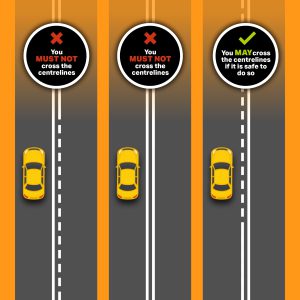From 29th January 2022, there were a number of changes to the Highway Code. Road users across England, Scotland, and Wales were asked to comply with the new changes.
At Halfords, we want all our customers to stay safe on the road, which is why we’ve put together this handy guide about what the new Highway Code rules mean for you.
The changes are designed to improve safety for vulnerable road users, particularly cyclists, pedestrians, and horse riders. The most significant changes are as follows:
Cyclists’ position on the road
The new Highway Code says that in the following situations, cyclists should ride in the centre of the lane to make themselves as visible as possible:
- On quiet roads or streets – if a faster vehicle comes up behind you, move to the left to enable them to overtake, if you can do so safely.
- In slower-moving traffic – when the traffic around you starts to flow more freely, move over to the left if you can do so safely, so that faster vehicles behind you can overtake.
- At the approach to junctions or road narrowings, where it would be unsafe for drivers to overtake you.
When riding on busy roads with faster-moving vehicles, cyclists should allow them to overtake, where it is safe to do so, whilst keeping at least half a metre away from the kerb edge.
Rule H1 – Hierarchy of Road Users
The new Highway Code rules are designed around a Hierarchy of Road Users. Pedestrians are placed at the top, as they are most likely to be injured in the event of a collision and, therefore, the most vulnerable. The hierarchy then proceeds with cyclists, horse riders, and motorcyclists.
All road users have a responsibility to be mindful of their own safety as well as the safety of others. As those in charge of larger vehicles are most likely to cause the greatest harm, they have the most responsibility to reduce the risk they pose to others. Likewise, cyclists and horse riders have a responsibility to reduce the risk they pose to pedestrians.
Rule H2 – Pedestrian priority
Motorists must now give way to pedestrians who are crossing or waiting to cross a road they are turning from or into.
Cyclists should give way to pedestrians on shared-use cycle tracks and horse riders on bridleways.
Rule H3 – Turning into or out of junctions
Drivers and motorcyclists must not cut across cyclists or horse riders when turning into or out of a junction or changing lanes. Motorists must wait for an appropriate gap in the flow of cyclists if needing to turn in or out of a junction or change lanes.
In addition to the new H1, H2, and H3 rules, there are a total of 49 amendments to existing rules. Some of the most notable rule updates are as follows:
Rules on overtaking
There is now further clarification as to how much space vehicles must leave when overtaking cyclists, pedestrians, and horse riders. Motorists must leave at least 1.5 meters when overtaking cyclists when travelling at speeds up to 30 mph and leave even more space when overtaking at higher speeds.
Motorists must pass horse riders at speeds of 10 mph or under, leaving at least 2 meters of space. Drivers must also allow at least 2 meters of space when passing pedestrians walking in the road and keep to a low speed.
For many drivers, there is confusion as to when you may overtake another vehicle. It’s extremely important to note the road markings. A solid white line is an indicator that you cannot overtake another vehicle. When in doubt, refer to the below image:

Opening your car door
Drivers are advised to open their car door using the hand on the opposite side to the door – for example, using your left hand to open the door on the right-hand side. This is known as the Dutch reach technique. The aim is that you are forced to turn your head and look over your shoulder, avoiding potential injury to cyclists riding nearby.
The government has released a full document highlighting the original Highway Code text and the alterations – the full copy of the changes can be found here. A full review of the Highway Code changes can also be found on the government website.
At Halfords, we’re always on hand to help provide a lifetime of safe motoring and cycling. For more safety tips whether you’re driving a car, a motorcycle, or riding a bike, the Halfords Blog is here to help!


